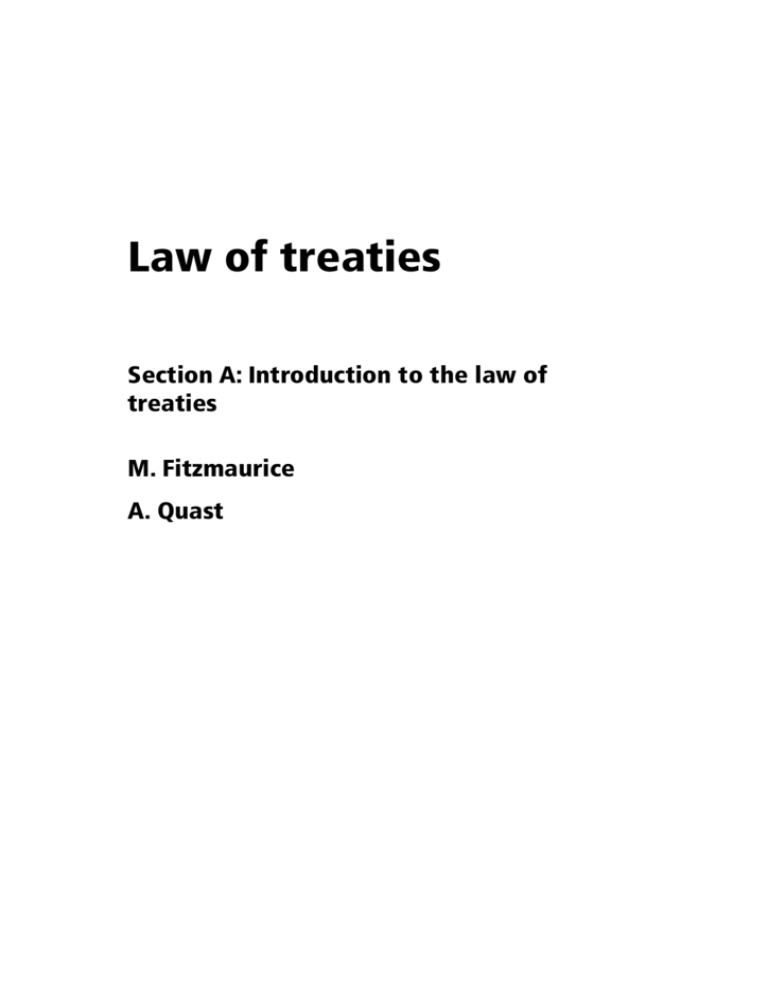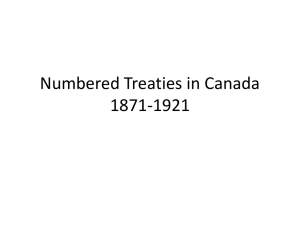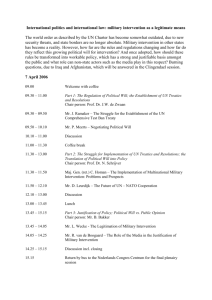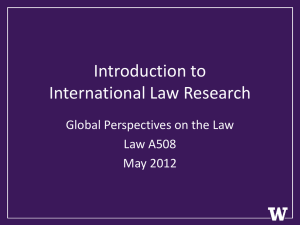
Law of treaties
Section A: Introduction to the law of
treaties
M. Fitzmaurice
A. Quast
This study guide was prepared for the University of London by:
M. Fitzmaurice, LLM, PhD (Warsaw). Professor of Public International Law, Department of Law, Queen
Mary, University of London.
A. Quast, 1st State Exam University of Bonn, Certificat de droit transnational University of Geneva, LLM
University of London (KCL).
This is one of a series of study guides published by the University. We regret that the
authors are unable to enter into any correspondence relating to, or arising from, the
guide.
If you have any comments on this study guide, favourable or unfavourable, please use the
form at the back of this guide.
Publications Office
The External Programme
University of London
Stewart House
32 Russell Square
London WC1B 5DN
United Kingdom
www.londonexternal.ac.uk
Published by the University of London Press
© University of London 2007
Printed by Central Printing Service, University of London
All rights reserved. No part of this work may be reproduced in any form, or by any means,
without permission in writing from the publisher.
Contents
Chapter 1
Introduction
1
1.1
Relevant conventions for the law of treaties
1
1.2
The International Court of Justice (ICJ)
3
1.3
Section A: Introduction to the law of treaties
4
1.4
How to use this study guide
5
Sources of international law with a
particular focus on treaties
9
Chapter 2
2.1
Classical sources of international law: Article 38 of the Statute
of the International Court of Justice (ICJ)
2.2
10
‘New’ sources of international law (not mentioned in Article 38
(1) ICJ Statute)
15
The norms of jus cogens (peremptory norms of international law)
17
The concept of a treaty in international law
21
3.1
The definition of a treaty in the VCLT 1969
22
3.2
Other criteria relevant for the definition of a treaty (criteria external
2.3
Chapter 3
to the definition contained in Article 2(1)a VCLT 1969)
23
iii
Chapter 4
Treaty-making process
25
4.1
Authority to conclude a treaty (accreditation and full powers)
26
4.2
Adoption and authentication of a treaty
27
4.3
Depositaries, registration and publication of treaties
28
Consent to be bound by a treaty
31
5.1
Classical means of expressing the consent to be bound by a treaty
33
5.2
‘New’ means of expressing ‘consent to be bound’
34
Chapter 5
iv
Chapter 2: Sources of international law with
a particular focus on treaties
Introduction
This chapter gives an overview of the sources of international law.
They include:
classical sources of international law, as listed in Article 38 (1)
of the Statute of the International Court of Justice
(<http://www.icj-cij.org/>), such as:
•
treaties
•
customary international law
•
general principles of international law
•
judicial decisions
•
writings of eminent jurists.
Other sources of international law include:
•
soft law
•
resolutions of organs of international organisations
•
unilateral acts
•
jus cogens.
Learning outcomes
By the end of this chapter and the relevant readings you should be able to:
list all the sources of international law
define a treaty
distinguish between the different types of treaties
describe the formation and elements of customary international law
enumerate important judicial decisions in the development of customary
international law
describe the interrelationship between customary international law and the
law of treaties
assess the role of general law principles in developing international law and
name examples of such principles
assess the importance of judicial decisions and writings of eminent jurists as
sources of international law
9
Law of treaties: Section A
consider the character and aims of soft law as a source of international law
consider the character and aims of resolutions of organs of international
organisations as a source of international law
define a unilateral act
define the concept of jus cogens.
Essential reading
General
Article 38 of the Statute of the International Court of Justice
(Harris, Annex 1).
Articles 53 and 64 of the Vienna Convention on the Law of Treaties 1969.
Article 103 of the UN Charter (Harris, Annex 1) (please see the
accompanying readings at the end of this section).
Jennings, R. and Watts, A. Oppenheim’s international law (London:
Longman, 1996) [ISBN 0582302455] ninth edition, pp.22–52 (please see
the accompanying readings at the end of this section).
Nicaragua case, ICJ Reports (1986), paras 175–190 (Harris, pp.893–898).
North Sea continental shelf cases, ICJ Reports (1969), paras 70–78 and 81
(Harris, pp.24–29).
The nuclear tests cases, ICJ Reports (1974), paras 43–51 (Harris,
pp.795–799).
Statement on Principles Applicable to the Formation of General Customary
Law, International Law Association, London 2000 part IV (please see the
accompanying readings at the end of this section).
Useful further reading
(Please note that this is suggested reading for you, if you have the time and the
inclination to read further in this area.)
Legal consequences of the construction of a wall in the occupied Palestinian
territory, Advisory Opinion of the International Court of Justice, ICJ Reports
(2004), paras 154–160.
Legality of the threat or use of nuclear weapons, Advisory Opinion of the
International Court of Justice, ICJ Reports (1996), paras 23–34, 37–39,
51–59, 64, 83, 97.
2.1
Classical sources of international law: Article
38 of the Statute of the International Court of
Justice (ICJ)
The International Court of Justice is the principal judicial organ of
the United Nations. Article 38 of the Statute is generally regarded
as providing the classic, non-exhaustive listing of international law
sources. It is contested whether the listing is hierarchical
(i.e. treaties being the most important, customary international
law, the second important source of international law, etc). In any
event, the sole explicit hierarchical element is contained in Article
10
Chapter 2: Sources of international law with a particular focus on treaties
38(1)d, referring to ‘subsidiary means for the determination of
rules of law’.
Article 103 UN Charter imposes the supremacy of obligations
stemming from the UN Charter for the UN Member States in case of
conflict with obligations deriving from any other international
agreement. In view of the fact that all States today are members of
the UN, this is an absolute rule for all States.
Jus cogens in general is a superior norm from which derogation is
not permitted and which can only be modified by another norm of
the same character. In case of conflict with any other norm, jus
cogens has an absolute priority (Articles 53 and 64 VCLT 1969).
The traditional view was that such a norm may only arise from a
treaty, but a more contemporary view acknowledges such a
possibility on the basis of international customary law.
Activity 2.1
Distinguish between the main and subsidiary sources of international law.
Feedback: page 18.
Reminder of learning outcomes
By this stage you should be able to:
list all the sources of international law.
2.1.1
Treaties
Treaties today are the most common source of international law
norms. Certain areas of international law, such as international
environmental law, are almost exclusively regulated by treaties. A
brief definition of a treaty is contained in Art. 2(1)a VCLT 1969.
However, this definition is only for the purpose of the Convention,
although it is assumed to reflect a general definition (with certain
exceptions – see below):
‘“Treaty” means an international agreement concluded between
States in written form and governed by international law, whether
embodied in a single instrument or two or more related instruments
and whatever its particular designation.’
Treaties may have different names, such as:
Convention
Agreement
Protocol
Pact
Charter.
Treaties concluded between States may be:
bilateral (i.e. concluded between two States)
multilateral (i.e. concluded by more than two States)
11
Law of treaties: Section A
or universal (i.e. if they bind almost all States (e.g. the 1945
UN Charter or the 1973 Convention on International Trade in
Endangered Species of Fauna and Flora – CITES – which has
almost 160 parties)).
The content of treaties
Regarding the content of treaties, the following distinction may be
made:
so-called ‘law-making treaties’ (traités lois)
and ‘contractual treaties’ (traités-contrats).
This division is based on the principle that the treaties of the first
category establish general patterns of behaviour for the parties over
a certain period of time in certain areas. The treaties belonging to
the second category regulate some specific co-operation between
States, such as a transboundary movement of specific hazardous
waste. However, a strict and inflexible division is very difficult to
uphold, as there is no clear-cut line between these two categories.
Another category of treaties is the so-called ‘normative treaties’.
These treaties correspond to an early concept of the abovementioned law-making treaties, as observed by the Special
Rapporteur of the International Law Commission, Alain Pellet, in
his 1998 report. They are not based on a contractual reciprocal
basis. However, a treaty is rarely entirely normative or entirely
reciprocal (synallagmatic). In most cases, there is a mixture or
variety of categories of norms.
Activity 2.2
Explain why treaties today are the primary source of international law.
Describe and explain the categories according to which treaties can be classified.
Feedback: page 18.
Reminder of learning outcomes
By this stage you should be able to:
define a treaty
distinguish between the different types of treaties.
2.1.2
Customary international law
Customary norms of international law arise when:
there is a practice amongst States to act in a particular way
States act because they believe that they are obliged to do so by
the law (the so-called opinio juris sive necessitates, in short
opinio juris).
Many important areas of general international law are based on
customary rules. In a number of cases, these have now been
incorporated into codifying conventions and some multilateral
12
Chapter 2: Sources of international law with a particular focus on treaties
conventions. The rules of international customary treaty law
codified in the VCLT 1969 are a good example of this.
However, the formation of such rules may often be a slow process.
It is difficult to establish which State practice meets the general
requirements for creating such a rule, as prescribed by the
International Court of Justice in the 1969 North Sea Continental
Shelf cases, such as:
generality
consistency
the relevance of participating States.
Even more difficult to establish is the subjective or psychological
element of opinio juris as:
States very often do not explain the motives or reasons for their
behaviour
it is still unclear whether it is decisive to establish opinio juris
according to what States do, or what they say.
Activity 2.3
Compare customary international law and treaty law.
Summarise the main points of the North Sea Continental Shelf cases in relation to
the formation of customary international law.
Feedback: page 18.
Reminder of learning outcomes
By this stage you should be able to:
describe the formation and elements of customary international law
enumerate important judicial decisions in the development of customary
international law.
2.1.3
Customary law and treaty rules
The interconnection between customary law and treaty rules can be
described in the following way:
codification (i.e. treaty codifies pre-existing customary
international law)
crystallisation (i.e. treaty helps to identify incipient rules of
customary international law)
formation (i.e. treaty is at the basis of the formation of a new
customary international law rule).
The International Court of Justice made general observations in
several cases as to the interrelationship between these two sources
of international law. The most important of these are the:
1969 North Sea Continental Shelf cases
1986 Nicaragua case.
13
Law of treaties: Section A
Activity 2.4
Summarise the main points of the 1969 North Sea Continental Shelf cases and
the 1986 Nicaragua case with regard to the interrelationship between customary
international law and treaty law.
Feedback: page 18.
Reminder of learning outcomes
By this stage you should be able to:
describe the interrelationship between customary international law and the
law of treaties.
2.1.4
General principles of international law
Article 38 of the statute of the ICJ refers, in this respect, to the
‘general principles of law recognized by civilised nations’. Again,
the theoretical basis of what is meant by this Statement (for
instance, whether this refers to principles coming from municipal
law systems or other systems of law) is a topic of general law on
sources.
In principle, there are certain general principles common to all
systems of law which can be identified.
These include the:
principle of good faith. This principle has fundamental
importance in the law of treaties, as codified in Article 26 VCLT
1969. This principle has been mentioned in many judgments of
the ICJ. Examples include the:
•
1974 Nuclear Test case, when the Court said ‘one of the
basic principles governing the creation and performance of
legal obligations, whatever their source, is the principle of
good faith’
•
1997 Gabcikovo-Nagymaros case (this case will be discussed
in Section B and Section D).
principle of equity. According to Brownlie, Principles of Public
International Law, sixth edition, page 25:
“‘Equity’ is used … in the sense of consideration or fairness,
reasonableness, and policy often necessary for the sensible
application of more settled rules of law. Strictly, it cannot be a
source of law and yet it may be an important factor in the process of
decision. Equity may play a … role in supplementing the law or
appear unobtrusively as a part of judicial reasoning.”
Many environmental treaties are based on this principle, such as
the 1997 United Nations Convention on Non-Navigational Uses of
International Watercourses.
Reminder of learning outcomes
By this stage you should be able to:
assess the role of general law principles in developing international law and
give some examples of such principles.
14
Chapter 2: Sources of international law with a particular focus on treaties
2.1.5
Judicial decisions and writings of eminent lawyers
Judicial decisions and writings of eminent lawyers are subsidiary
means for determining the rules of international law. However,
they differ in importance between themselves. Judicial decisions
play an important role in stating the rules of international law, in
particular the judgments and advisory opinions of the International
Court of Justice. Although the judgments only bind the parties to a
case and in that particular case, the authority of the
pronouncements of the ICJ is immense. The Court helps to identify
and crystallise the rules of international law.
However, the importance of other international courts and
tribunals should not be underestimated. The pronouncements of
international courts and tribunals are a very important source of
identification of the relevant rules of international law. They
include the:
International Tribunal for the Law of the Sea
< http://www.itlos.org/ >
International Courts of Human Rights
< http://www.echr.coe.int/echr >
< http://www.corteidh.or.cr/stars.html >
International criminal courts
< http://www.icc-cpi.int/home.html >
< http://www.un.org/icty/ >
Iran–United States claims tribunal.
< http://www.iusct.org/ >
We also should take into account the decisions of quasi-judicial
bodies, such as:
the United Nations Compensation Commission
< http://www2.unog.ch/uncc/ >
international arbitration tribunals
The Permanent Court of Arbitration:
< http://www.pca-cpa.org/ >
The writings of eminent jurists are of lesser importance in today’s
world. However, they are still mainly relied upon by lawyers in
proceedings before national courts.
Reminder of learning outcomes
By this stage you should be able to:
assess the importance of judicial decisions and writings of eminent jurists as
sources of international law
2.2
‘New’ sources of international law (not
mentioned in Article 38 (1) ICJ Statute)
2.2.1
Soft law
Soft law instruments are non-binding and sometimes preferable to
States in order to avoid binding obligations and the consequences
15
Law of treaties: Section A
of their non-performance. The legal character of these instruments
is disputed and not entirely clear. Soft law provisions often are
incorporated in treaties such as the 1992 UN Framework
Convention on Climate Change.
Examples of soft law are various non-binding declarations such as
the:
1972 Stockholm Declaration on Human Environment
1992 Rio Declaration on Development and Environment.
These non-binding provisions may acquire binding force over time
through the workings of international customary law (such as
Principle 21 of the 1972 Stockholm Declaration (above) on the
prohibition of transboundary environmental harm). Alternatively,
they may harden into a binding treaty (e.g. the 1988 Baltic Sea
Ministerial Declaration, which hardened into the 1992 Helsinki
Convention on the Protection of the Environment of the Baltic Sea
Area).
2.2.2
Resolutions of organs of international organisations
Resolutions of organs of international organisations may have a
dual legal effect:
internally – in relation to internal matters they might be
binding on the Member State of those organisations or other
organs (depending on the treaty establishing the organisation)
externally – in relation to Member States or other States they
are usually not binding. However, they can acquire such a legal
force through the workings of customary international law.
Out of all the resolutions of organs of international organisations,
the resolutions adopted by the organs of the United Nations
(e.g. the General Assembly (GA) and the Security Council) are of
particular importance. The basic rule for GA resolutions is that they
are non-binding (externally), even if adopted unanimously.
However, they may:
state customary international law
provide evidence of State practice and opinio juris.
The legal effects of resolutions of the UN General Assembly were
discussed in the 1996 ICJ Nuclear Weapons Advisory Opinion.
Activity 2.5
Compare the legal character of soft law with the legal character of a treaty.
Explain how non-binding resolutions may become a norm of customary
international law.
Feedback: page 18.
Reminder of learning outcomes
By now you should be able to:
consider the character and aims of soft law as a source of international law
consider the character and aims of resolutions of organs of international
organisations as a source of international law.
16
Chapter 2: Sources of international law with a particular focus on treaties
2.2.3
Unilateral acts
A further source of international law may be unilateral acts of
States. However, this is an exceptional situation as they acquire
legally binding force only under certain circumstances. These
circumstances were specified by the ICJ in the 1974 Nuclear Test
cases if:
there is a specific intention to create a legal undertaking
the announcement is given publicly and made by persons
authorised to engage the State.
Unilateral acts need to be distinguished from treaties and
customary international law:
as the binding force results from the State’s own will1
with regard to customary international law as their process of
formation is entirely different2
depending on the circumstances, they can be binding with
regard to one State, several States or even all States (erga
omnes).
1
Contrast this with treaty obligations
where States create obligations through
mutual agreement.
2
Compare the section on customary law
with the finding of the ICJ in the 1974
Nuclear Tests cases.
However, similar to treaties, unilateral acts need to be based on the
principle of good faith.
2.3
The norms of jus cogens (peremptory norms of
international law)
These norms are not a source of international law in a strict sense,
but they indicate the hierarchy of the norms of international law.
Article 53 VCLT 1969 defines, for the purposes of that Convention,
the term of ‘peremptory norm of general international law’ as a
norm:
which is accepted and recognised by the international
community of a State as a whole
from which no derogation is permitted
which can be modified only by a subsequent norm of general
international law having the same character.
Furthermore, Article 53 sets out that a treaty is void if, at the time
of its conclusion, it conflicts with such a norm. In consequence, the
rules of jus cogens are rules of a fundamental character of
customary international law that cannot be modified by a treaty.
According to Article 64 VCLT, any treaty provision which conflicts
with a rule of jus cogens is void, whether or not this rule developed
before or after the treaty came into force. Examples of norms of jus
cogens are the prohibition of:
the use of force
slavery
piracy
genocide.
The problems raised by norms of jus cogens were discussed in the
1996 ICJ Nuclear Weapons Advisory Opinion. The above-mentioned
examples are widely accepted as norms of jus cogens by the
17
Law of treaties: Section A
international community. However, it is difficult to make any
addition to this list as the requirements for the creation of or
classification as such a norm of jus cogens are very high (and
abstract) and the legal consequences flowing from this creation or
classification are far-reaching for the community of States.
Reminder of learning outcomes
By now you should be able to:
list all the sources of international law
define a treaty
distinguish between the different types of treaties
describe the formation and elements of customary international law
enumerate important judicial decisions in the development of customary
international law
describe the interrelationship between customary international law and the
law of treaties
assess the role of general law principles in developing international law and
name examples of such principles
assess the importance of judicial decisions and writings of eminent jurists as
sources of international law
assess the importance of judicial decisions and writings of eminent jurists as
sources of international law
consider the character and aims of soft law as a source international law
consider the character and aims of resolutions of organs of international
organisations as a source of international law
define a unilateral act
define the concept of jus cogens.
Feedback to activities: Chapter 2
Activity 2.1 You will need to compare the characteristics of treaty law with the
characteristics of other sources (mainly customary international law) to find out
the advantages of treaty law over those other sources.
Activity 2.2 You will need to remind yourself of Article 38 of the Statute of the
ICJ which refers explicitly to the main distinction between those two groups of
sources. You will need to remind yourself of the functions of these two groups.
Activity 2.3 You will need to remind yourself about the formation,
characteristics and the functions of these two sources of international law. You
will need to read the relevant paragraphs of the North Sea Continental Shelf
cases and identify the elements of the formation of customary international law.
Activity 2.4 You will need to read the relevant paragraphs of the North Sea
Continental Shelf cases and identify the ways in which customary international
law and treaties interact.
Activity 2.5 You will need to remind yourself of what a treaty and soft law are
as described above. You will need to remind yourself of the formation of
customary international law and apply this to the resolutions of organs of
international organisations.
18
Chapter 2: Sources of international law with a particular focus on treaties
Sample examination questions
Question 1 Analyse the process of the formation of customary international law,
including references to the relevant case-law.
Question 2 Explain the different ways of interaction between treaties and
customary international law, including references to the relevant case-law.
Question 3 Explain the functions of a treaty and explain why today treaties are
the primary source of international law.
Advice on answering the questions
Question 1 You should describe the elements of the formation of customary
international law as identified by the ICJ in the 1969 North Sea Continental Shelf
cases and the 1986 Nicaragua case. You should also be able to distinguish
between the practice of States and opinio juris and the respective difficulties
relating to both elements.
Question 2 You should read the ICJ 1969 North Sea Continental Shelf cases and
distinguish three ways in which treaty law and customary international law can
interact according to the ICJ.
Question 3 You should note the:
clear character of treaty provisions
binding character of treaty provisions
possibility to depart from customary international law between the parties.
Find further reasons why certain areas of international law are almost entirely
regulated by treaties and give examples of certain treaties and such areas. You
should also explain the difference between contractual and law-making treaties.
19








